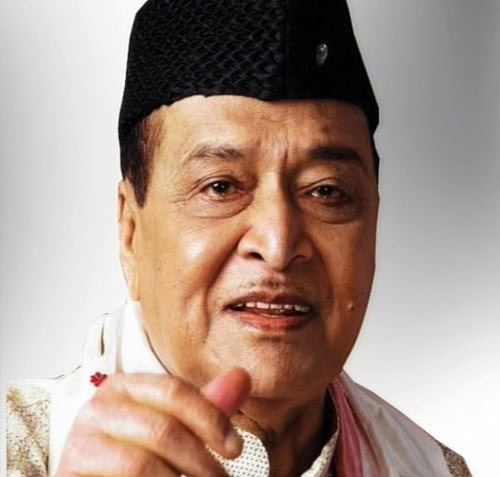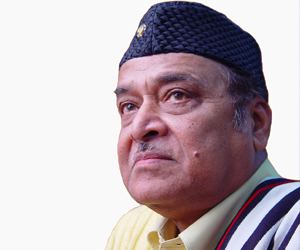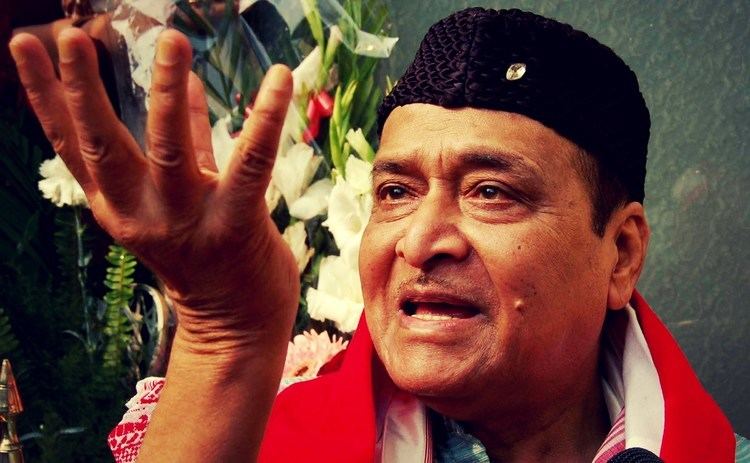Nationality Indian Role Lyricist Name Bhupen Hazarika | Years active 1939-2011 | |
 | ||
Occupation Musician, singer, poet, filmmaker, lyricist Notable work RudaaliDarmiyaan: In BetweenGaja GaminiDamanIndramalati Movement Indian Peoples Theater Association Spouse Priyam Hazarika (m. 1950–2011) Similar People Jayanta Hazarika, Mayukh Hazarika, Gulzar, Hemant Kumar, Mohammed Rafi | ||
Bhupen hazarika in unki nazar unka shahar
Bhupen Hazarika was an Indian playback singer, lyricist, musician, singer, poet and film-maker from Assam, widely known as Sudhakantha. His songs, written and sung mainly in the Assamese language by himself, are marked by humanity and universal brotherhood and have been translated and sung in many languages, most notably in Bengali and Hindi. His songs, based on the themes of communal amity, universal justice and empathy, have become popular among the people of Assam, besides West Bengal and Bangladesh. He is also acknowledged to have introduced the culture and folk Music of Assam and Northeast India to Hindi cinema at the national level. He received the National Film Award for Best Music Direction in 1975. Recipient of Sangeet Natak Akademi Award (1987), Padmashri (1977), and Padmabhushan (2001), Hazarika was awarded with Dada Saheb Phalke Award (1992), India's highest award in cinema, by the Government of India and Sangeet Natak Akademi Fellowship (2008), the highest award of the Sangeet Natak Akademi, India's The National Academy for Music, Dance and Drama. He was posthumously awarded the Padma Vibhushan, India's second-highest civilian award, in 2012. Hazarika also held the position of the Chairman of the Sangeet Natak Akademi from December 1998 to December 2003.
Contents
- Bhupen hazarika in unki nazar unka shahar
- Thousands join final journey of legendary bhupen hazarika
- Early life
- Education and career
- IPTA years
- Professional life
- Later life
- Death
- Legacy and influences
- Awards and honors
- References

Thousands join final journey of legendary bhupen hazarika
Early life

Hazarika, who made fame as a musician, was born on 8 September 1926 to Nilakanta and Shantipriya Hazarika in Sadiya(শদিয়া), Assam. His father was originally from Nazira, a town located in Sivasagar district. The eldest of ten children, Bhupen Hazarika (as also his siblings) was exposed to the musical influence of his mother, who exposed him to lullabies and traditional Music of Assam. His father moved to the Bharalumukh region of Guwahati in 1929, in search of better prospects, where Bhupen Hazarika spent his early childhood. In 1932 his father further moved to Dhubri, and in 1935 to Tezpur. It was in Tezpur that Bhupen Hazarika, then 10 years of age, was discovered by Jyotiprasad Agarwala, the noted Assamese lyricist, playwright and the first Assames Filmmaker and Bishnu Prasad Rabha, renowned Assamese artist and revolutionary poet, where he sang a Borgeet (the traditional classical Assamese devotional songs written by Srimanta Sankardeva and Sri Sri Madhabdeva), taught by his mother at a public function. In 1936, Bhupen Hazarika accompanied them to Kolkata where he recorded his first song at the Aurora Studio for the Selona Company. His association with the icons of Assamese Culture at Tezpur was the beginning of his artistic growth and credentials. Subsequently, Hazarika sang two songs in Agarwala's film Indramalati (1939): Kaxote Kolosi Loi and Biswo Bijoyi Naujawan at the age of 12. He wrote his first song, Agnijugor Firingoti Moi at the age of 13 and he was well on his way to becoming a lyricist, composer and singer.
Education and career
He studied at Sonaram High School at Guwahati, Dhubri Government High School and matriculated from Tezpur High School in 1940. He completed his Intermediate Arts from Cotton College in 1942, and his BA (1944) and MA (1946) in Political Science from Banaras Hindu University. For a brief period he worked at All India Radio, Guwahati when he won a scholarship from Columbia University and set sail for New York in 1949. There he earned a PhD (1952) on his thesis "Proposals for Preparing India's Basic Education to use Audio-Visual Techniques in Adult Education". In New York Bhupen Hazarika befriended Paul Robeson, a prominent civil rights activist, who influenced him in his song Bistirno parore which is based on the imagery and theme of Robeson's Ol' Man River. This song is translated in various Indian languages, including Bengali and Hindi and sung by the artist himself, and is still popular. Being inspired from some other foreign ones, he also composed several other songs in Indian languages. He was exposed to the Spiritual, and the multi-lingual version of We are in the Same Boat Brother became a regular feature in his stage performance. At Columbia University, he met Priyamvada Patel, whom he married in 1950. Tez Hazarika, their only child, was born in 1952, and he returned to India in 1953.

His famous songs include (in Assamese):

- Bistirno Parore
- Moi Eti Jajabor
- Ganga Mor Maa
- Bimurto Mur Nixati Jen
- Manuhe Manuhor Babey
- Snehe Aamar Xoto Shrabonor
- Gupute Gupute Kimaan Khelim
- Buku Hom Hom Kore
IPTA years
Hazarika began close association with the leftist Indian People's Theatre Association soon after returning from the USA in 1953 and became the Secretary of the Reception Committee of the Third All Assam Conference of IPTA, held in Guwahati in 1955.
Professional life
After completing his MA he briefly worked at the All India Radio station at Guwahati before embarking for his doctoral studies at Columbia University. His thesis "DEMYSTIFYING DR. BHUPEN HAZARIKA: envisioning education for India", edited by Tej Hazarika and published by Cool Grove Press will be available in the US in days.Soon after completing his education, he became a teacher at the Gauhati University. But after a few years, he left the job and went to Kolkata where he established himself as a successful music director and singer. During that period, Hazarika made several award-winning Assamese films such as Shakuntala, Pratidhwani, etc. and composed evergreen music for many Assamese films. He was also considered as a new trend setter in Bengali music. The famous musical genre of West Bengal, the Jivanmukhi geet started by Kabir Suman in 1990's is thought to be influenced by Hazarika. Bhupen Hazarika composed music for films from Bangladesh too which got international acclaim. He was elected the President of the Asam Sahitya Sabha in 1993. In 1967, Hazarika got elected as a member of Assam Assembly from Nauboicha Constituency.
Social Struggle
From early in his life, he was at the forefront of a social battle against the entrenched forces of casteism that sneered at a member of the ‘Dom' community making it as a musician of note, and kept him away from the upper-caste Brahmin woman he had loved. Eventually, when the spirited Hazarika did marry, it was to a Brahmin woman, his revenge of sorts against a caste-ridden society.
Later life
He was introduced to Kalpana Lajmi in the early 1980s by his friend Hemendra Prasad Barooah in Kolakata. Her first feature film Ek Pal with music score by Dr Bhupen Hazarika was produced by Dr Hazarika's childhood friend and India's top tea planter Hemendra Prasad Barooah, (' on IMDb) (1986). Subsequently, Lajmi began assisting him professionally and personally till the end of his life. In the period after the release of Ek Pal (1986) until his death, Bhupen Hazarika mainly concentrated on Hindi films, most of which were directed by Kalpana Lajmi. Ek Pal (1986), Rudaali (1993) and Daman: A Victim of Marital Violence (2001) are major films this period. Many of his earlier songs were re-written in Hindi and used as played-back songs in these films. These songs tried to cater to the Hindi film milieu and their social activist lyrics were browbeaten into the lowest common denominator. He served as an MLA (Independent) during 1967-72 in the Assam Legislative Assembly from Nauboicha Constituency. He contested as a Bharatiya Janata Party candidate in the 2004 Lok Sabha elections from the Guwahati constituency, persuaded by Chandan Mitra via Kalpana Lajmi which he lost to the Indian National Congress candidate Kirip Chaliha.
Death
Hazarika was hospitalized in the Kokilaben Dhirubhai Ambani Hospital and Medical Research Institute in Mumbai in 2011. He was admitted to the intensive care unit on 30 June 2011. He died of multi-organ failure on 5 November 2011. His body lay in state at Judges Field in Guwahati and cremated on 9 November 2011 near the Brahmaputra river in a plot of land donated by Gauhati University. His funeral was attended by an estimated half a million people.
Legacy and influences
As a singer, Hazarika was known for his baritone voice and diction; as a lyricist, he was known for poetic compositions and parables which touched on themes ranging from romance to social and political commentary; and as a composer, for his use of folk music. In a poll conducted in Bangladesh, his song, Manush Manusher Jonno (Humans are for humanity)' was chosen to be the second most favourite number after the National anthem of Bangladesh. Some of his most famous compositions were adaptations of American Black Spiritual that he had learned from Paul Robeson, whom he had befriended during his years in New York City in the early 1950s. His famous song "Bistirno Parore" is heavily influenced by Ol' Man River sung by Paul Robeson.
During his lifetime, a full length docu-feature biopic film on his life titled Moi Eti Zazabor('I am a Wanderer') jointly directed by Late Waesqurni Bora and Arnab Jan Deka was launched in 1986 at his Nizarapar residence in Guwahati city. Music for this biopic film has been scored by 5-time International Best Music Awards winner only Assamese musician, songwriter, composer and singer Jim Ankan Deka, who also worked as Chief Assistant Director of this film. During the next two decades, the joint directors Late Bora and Deka shot him live for the film during his various public performances all over India, as well as many private moments in his domestic and social life. Arnab Jan Deka also extensively interviewed him regarding his life and its creative aspects for the film, which had been recorded during their joint travel to different metropolises and remote corners of Assam and rest of India. The film has been under production since 1986 with film negative footage of more than 16 hours currently preserved in different film laboratories in Bombay(Mumbai), Calcutta(Kolkata) and Madras(Chennai). The film was targeted for public release during the lifetime of Dr Bhupen Hazarika in 2008. But, the production was halted after sudden demise of one of the Co-Directors Waesqurni Bora in November 2008. Eventually, after the death of Dr Hazarika, the film's subject, the surviving Co-Director Arnab Jan Deka is currently carrying out necessary works to finish the film at the earliest and release for public consumption in several language versions including English, Assamese, Bengali and Hindi, with support from Late Waesqurni Bora's widowed wife Nazma Begum and Dr Hazarika's bereaved family members including his wife Priyam Hazarika and Tej Hazarika. Meanwhile, two books describing the unforgettable experiences of the making of this milestone biopic film had been authored by its co-director Arnab Jan Deka titled Anya Ek Zazabor and Mor Sinaki Bhupenda, first of which had been officially released in February 1993 by Late G P Sippy, then President of Film Federation of India and producer of world-record holder Hindi film Sholay at a public function organised by Dr Bhupen Hazarika himself.
